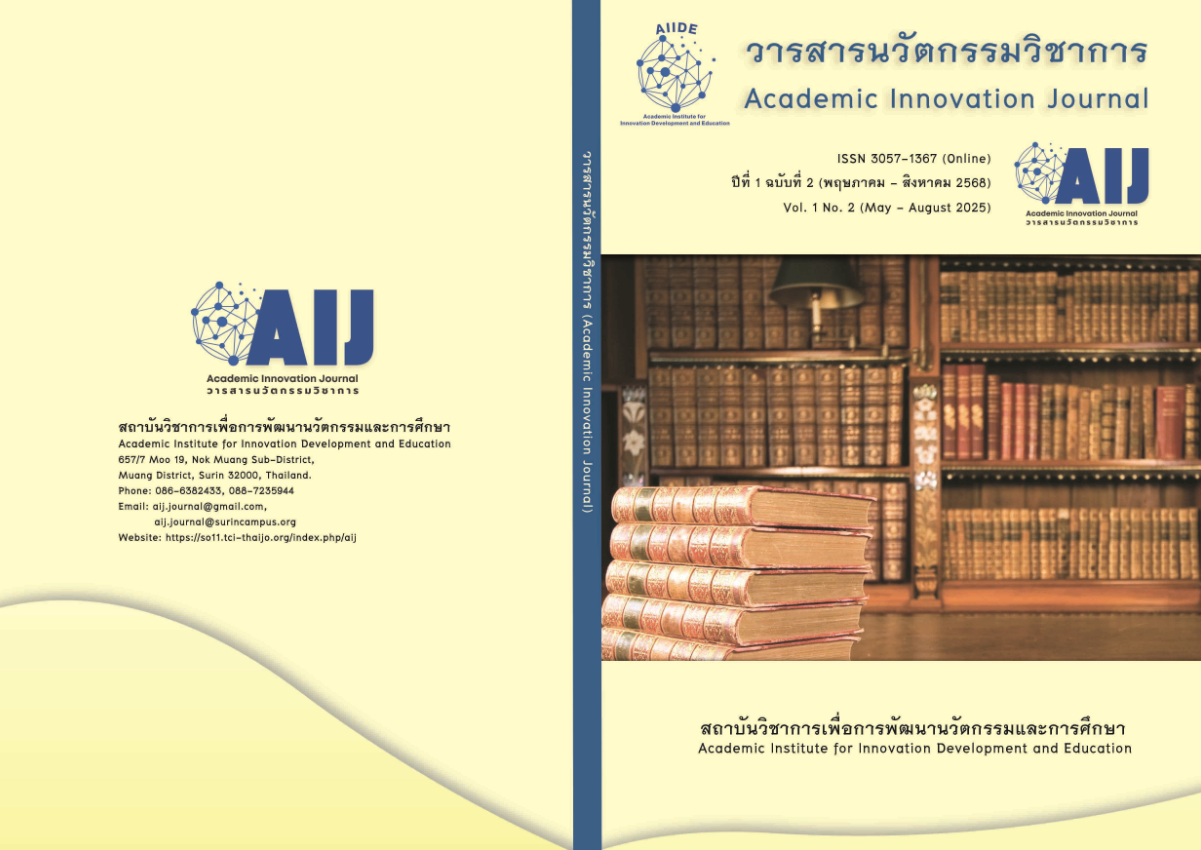Social Innovation Evaluation Tool: A Case Study of The Healthy Subdistrict Project of the Thai Health Promotion Foundation
Main Article Content
Abstract
This research aims (1) to review the body of literature on the evaluation of social innovation and (2) to design an evaluation instrument for social innovation. The Healthy Subdistrict Project of the Thai Health Promotion Foundation (ThaiHealth) is employed as a case study and primary data source for analysing and constructing the proposed instrument. The study adopts a mixed qualitative approach—document analysis and qualitative inquiry—collecting empirical evidence through in depth interviews with 20 key informants and verifying the data by means of member checking. Findings indicate that the social innovation evaluation instrument comprises four essential sections that together allow a concise yet comprehensive synthesis of community based innovation: (1) General Information – project profile and project management system. (2) Social Innovation – type and thematic focus of the innovation, target beneficiaries, and innovation leadership. (3) Social Impact – outcomes mapped against the Sustainable Development Goals (SDGs). and (4) Policy Recommendations – actionable suggestions for scaling and institutional support.
Downloads
Article Details

This work is licensed under a Creative Commons Attribution-NonCommercial-NoDerivatives 4.0 International License.
References
Braun, V., & Clarke, V. (2006). Using thematic analysis in psychology. Qualitative Research in Psychology, 3(2), 77–101. https://doi.org/10.1191/1478088706qp063oa.
Bund, E., Gerhard, U., Hoelscher, M., & Mildenberger, G. (2015). A Methodological Framework for Measuring Social Innovation. Historical Social Research, 40.3, 48-78.
Charoensak, P. (2024). Happiness of Thai Older Workers. [Doctoral dissertation, Chulalongkorn University]. CUIR at Chulalongkorn University. https://cuir.car.chula.ac.th/handle/123456789/86531. (In Thai)
Charoensak, P. (2025). Community Innovation. Learn Kon Tai. https://www.facebook.com/photo.php?fbid=694616350106104&set=pb.100086732341370.-2207520000&type=3. (In Thai)
European Commission. (2013). Guide to Social Innovation. Publications Office. https://data.europa.eu/doi/10.2776/72046.
Global Innovation Fund. (2024). 2023 Impact Report. https://boundless-glider.files.svdcdn.com/production/uploads/PDF-Documents/Impact-Reports/Global-Innovation-Fund-2023-Impact-Report.pdf.
MIT ADT University. (2021). Types of Social Innovation. https://mitidinnovation.com/blog/type-of-social-innovation.
Nastasi, B. K., & Schensul, S. L. (2005). Contributions of Qualitative Research to the Validity of Intervention Research. Journal of School Psychology, 43(3), 177–195. https://doi.org/10.1016/j.jsp.2005.04.003.
National Innovation Agency Academy MOOCs. (n.d.). Innovation 101. https://moocs.nia.or.th/course/innovation-101. (In Thai)
National Innovation Agency. (2019). Appropriate Social-Impact Indicators. https://social.nia.or.th/wp-content/uploads/2019/12/Index.pdf. (In Thai)
Nesta. (2008). Social Innovation: New Approaches to Transforming Public Services. https://media.nesta.org.uk/documents/social_innovation.pdf.
Office of National Higher Education Science Research and Innovation Policy Council. (2022). Social Innovation Indicator Framework Report (2021–2022). https://stiic.sti.or.th/wp-content/uploads/2022/09/Report-Social-Innovation-Indicator-Framework-ตัวชี้วัดนวัตกรรมสังคม-โดยฝ่ายข้อมูล-สอวช-PDF.pdf. (In Thai)
Rattanadilok Na Phuket, N., & Charoensak, P. (2023). Childent and Youths for Strong Community Creation. Journal of MCU Social Science Review, 12(2), A95-A104. (In Thai)
Rattanadilok Na Phuket, N., & Samukkethum, S. (2023). Developing Model of Healthy Tambon Project Thai Health Promotion Foundation Implementation. School of Administrative Studies Academic Journal, 6(4), 54–71. (In Thai)
RESINDEX. (2014). A Regional Index to Measure Social Innovation. https://sinnergiak.org/wp-content/uploads/2014/06/2014_RESINDEX_eng.pdf.
Saenserm, K. S., Rattanadilok Na Phuket, N., Charoensak, P., & Chongwithukit, C. (2024). A Social-Capital Analysis Tool for Developing Strong Local Communities. Thai Health Promotion Journal, 3(3), 230-238. (In Thai)
SIMPACT. (2016). Social Innovation Evaluation Toolbox. https://www.simpact-project.eu/tools/toolbox_evaluation_web.pdf.
Social Innovation Exchange. (2024). People-Powered Change: Insights from the Social Innovation Indaba 2024. https://socialinnovationexchange.org/wp-content/uploads/2025/01/SIX-Indaba-Report.pdf.
TEPSIE. (2014). Social Innovation Theory and Research: A Guide for Researchers. https://youngfoundation.org/wp-content/uploads/2015/04/YOFJ2785_Tepsie_A-guide_for_researchers_06.01.15_WEB.pdf.
Thai Health Promotion Foundation. (2022). Master Plan (2023–2027). Thai Health Promotion Foundation Press. (In Thai)
Thai Health Promotion Foundation. (n.d.). Health Promotion Innovation. https://dol.thaihealth.or.th/File/media/ad3467fc-baa5-45df-ad36-27d03eca863b.pdf (In Thai)
ThaiHealth Official. (2018). Social Innovation: A Survival Option for Thai Health. Thai Health Promotion Foundation. https://www.thaihealth.or.th/?p=238250. (In Thai)
United Nations. (2025). Sustainable Development Goals. https://sdgs.un.org/goals.
World Economic Forum. (2016). Social Innovation: A Guide to Achieving Corporate and Societal Value. https://www3.weforum.org/docs/WEF_Social_Innovation_Guide.pdf.


